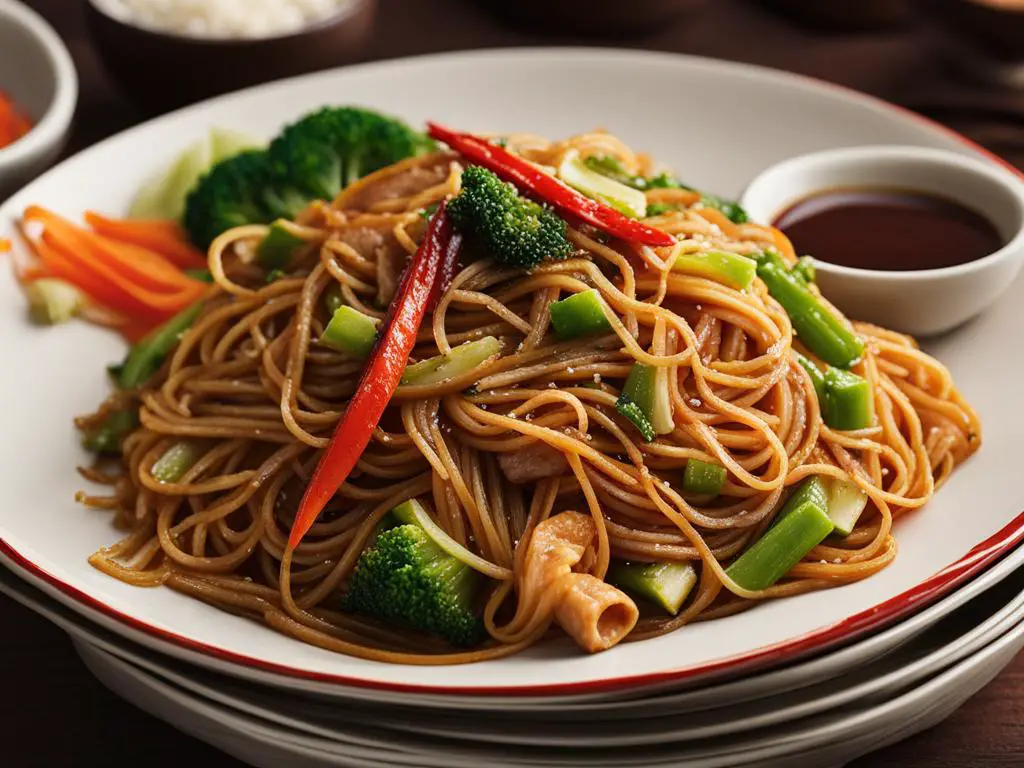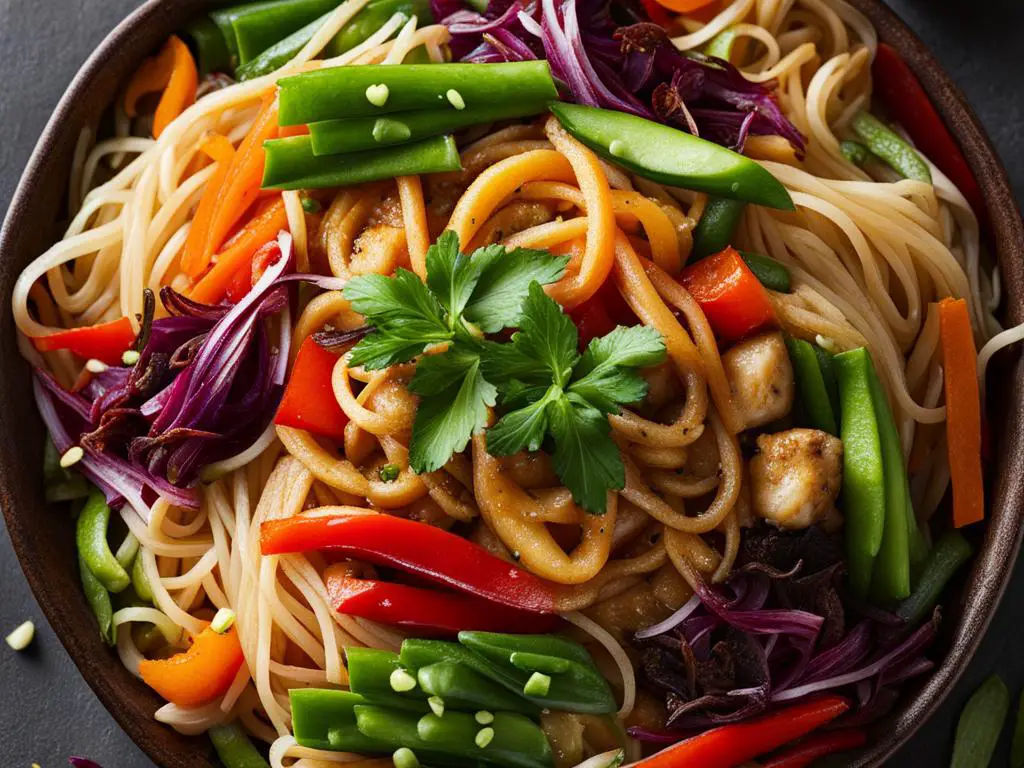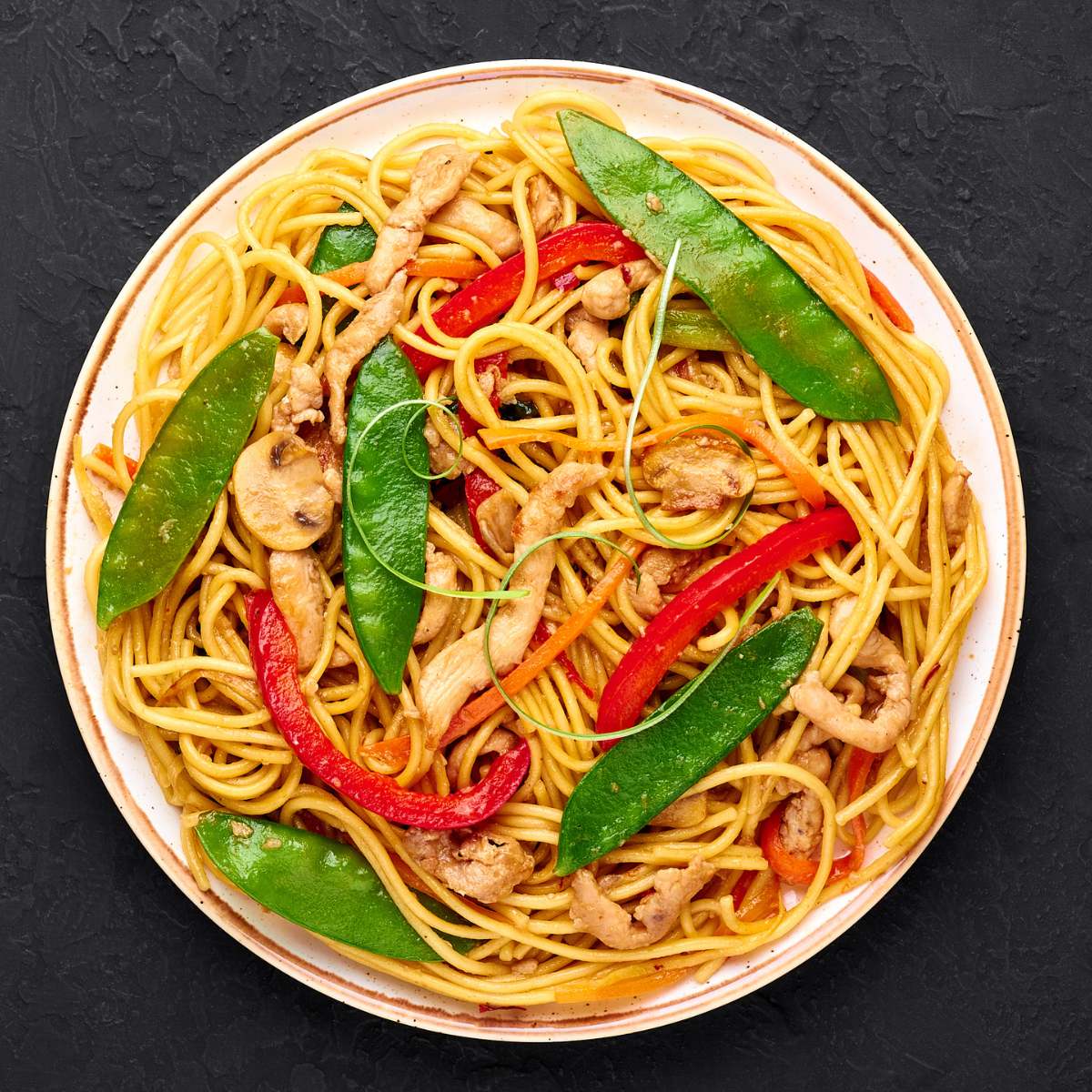Curious about what is Lo Mein? Well, it’s time to turn your kitchen into a flavor workshop and whip up this classic dish yourself.
This article will guide you through the basics of Lo Mein, from choosing the right noodles and sauce to perfecting the stir-fry technique. We’ll also explore how to personalize your Lo Mein with different proteins and vegetables, ensuring every dish is uniquely delightful.
So, stay tuned as we unravel the secrets to achieving that perfect balance of flavors and textures in your homemade Lo Mein. Keep reading to discover why this dish is a beloved favorite in Chinese cuisine and beyond!
What is Lo Mein
Lo Mein is a beloved Chinese dish known for its versatility and rich flavors. These soft wheat noodles are typically stir-fried with a variety of vegetables and proteins like chicken, beef, or shrimp, all coated in a savory sauce. The appeal of Lo Mein lies in its ability to stand alone as a hearty, satisfying meal or serve as part of a larger feast alongside other dishes.
Its name, which translates to “tossed noodles,” perfectly describes the method of tossing the noodles in the sauce to ensure each strand is evenly seasoned. This dish is not only a staple in Chinese cuisine but also a comforting favorite worldwide, offering a delicious blend of texture and taste that nourishes both the body and soul.
Distinguishing Lo Mein from Chow Mein
Curious about the noodles on your plate? Lo Mein and Chow Mein are both beloved staples in Chinese cuisine, yet they differ distinctly in preparation and texture. Lo Mein, which means “tossed noodles,” features noodles that are boiled to softness and then tossed with sauce, making them smooth and slightly slick.
Chow Mein, or “fried noodles,” presents a crunchier delight, as the noodles are stir-fried to a crisp before being mixed with meats and vegetables. This gives them a distinctly different texture from the softer Lo Mein noodles.
Related Article: Want to know how Lo Mein compares to other noodle variations? Explore our articles on Mei Fun vs Lo Mein, Chow Fun vs Lo Mein, Pad Thai vs Lo Mein, and Pan Fried Noodles vs Lo Mein to discover which noodle dish might become your new favorite.
Lo Mein’s Migration to American Chinese Food
Fast-forward to the vibrant Chinese-American neighborhoods, where the beloved dish took on a new life. As Chinese immigrants brought their flavors to the United States, Lo Mein became a signature star in the world of Chinese American cuisine.
American palates welcomed this hearty dish, which embraced local ingredients and took a novel turn with an all-American twist. What emerged was a testament to the dish’s versatility and its ability to become a bridge connecting diverse cultures and palates. It’s not just noodles; it’s the embodiment of a cultural food evolution.
Now, let’s lay out a table of contrasts highlighting the traditional and the American twist on Lo Mein:
| Traditional Lo Mein | American Chinese Lo Mein |
|---|---|
| Hand-pulled wheat noodles | Pre-packaged or factory-made noodles |
| Sauce made from a delicate balance of soy and sesame oil | Richer and often sweeter sauce varieties |
| Seasonal vegetables and strips of pork or chicken | A diverse array of proteins, including shrimp and beef |
| Commonly eaten as a standalone dish or with a simple side | Often part of a larger multi-course meal |
Mastering Lo Mein Noodles

Crafting the perfect Lo Mein starts with mastering the noodles, the heart of this beloved dish. Lo Mein hinges on the texture of its egg noodles, which should be springy and chewy unlike the softer rice noodles often found in other noodle dishes. When cooked correctly, they provide the ideal foundation for the rich sauces and varied toppings typical in Lo Mein.
Here’s how to cook them to perfection:
- Cooking ‘Al Dente’: Begin by boiling the noodles just until they are tender yet firm to the bite, known as ‘al dente’. This ensures they maintain a nice chewiness without becoming mushy.
- Preventing Sogginess: Immediately after cooking, drain the noodles and give them an ice water bath. This stops the cooking process and prevents the noodles from becoming soggy, locking in the perfect texture.
- Stir-Frying to Finish: Finally, transfer the cooled noodles to a hot wok or skillet for stir-frying. This high-heat cooking method brings out the best in the noodles, allowing them to absorb flavors while retaining a delightful springiness.
By following these steps, you can achieve restaurant-quality Lo Mein right in your own kitchen. Each noodle will be perfectly cooked to hold its own against the savory sauces and vibrant mix-ins of your dish.
Related Article: Want a deeper dive into the differences between egg noodles and rice noodles? Check out our article on Rice Noodle vs Egg Noodle for more insights.
Crafting the Perfect Lo Mein Sauce
To make the perfect Lo Mein sauce, it’s all about finding the right balance of flavors and achieving that irresistibly smooth texture. Here’s what makes up this iconic sauce:
- Soy Sauce: The foundation of the sauce, providing a rich, savory flavor that defines the dish.
- Sesame Oil: Adds a hint of nutty aroma, enhancing the complexity without overwhelming the other flavors.
- Ginger: Offers a sharp, zesty punch that brightens the overall taste.
- Sugar: A touch of sweetness to counterbalance the saltiness and richness.
- Cornstarch: The key to thickening the sauce, giving it a silky texture that coats the noodles beautifully.
Together, these ingredients meld to create a sauce that’s harmonious and full-bodied, perfect for dressing the noodles and complementing any added proteins or vegetables.
Classic Veggies in Lo Mein and Their Substitutes
Familiar with the usual suspects in a classic Lo Mein? Cremini mushrooms, carrots, and snow peas might be your go-to, but don’t fret if they’re missing from your pantry. Here’s a quick guide for clever swap-ins that keep your Lo Mein lively and luscious!
| Classic Vegetable | Substitute | Why It Works |
|---|---|---|
| Cremini Mushrooms | Portobello or Shiitake Mushrooms | They offer a similar earthiness and meaty texture. |
| Red Bell Pepper | Yellow or Orange Bell Pepper | They provide a sweet flavor and add a pop of color. |
| Julienned Carrots | Zucchini or Summer Squash | They bring a different, yet delightful crunch. |
| Snow Peas | Sugar Snap Peas or French Green Beans | They maintain the crisp snap and keep the dish vibrant. |
Protein Choices to Complement Your Lo Mein
When crafting your Lo Mein, the choice of protein can transform this dish from a simple noodle meal to a hearty, satisfying entree. Whether you prefer the rich flavors of animal-based proteins or lean towards plant-based alternatives, the right protein can enhance both the texture and taste of your Lo Mein.
Choosing the Right Protein for Your Lo Mein
Below is a guide to selecting proteins that complement the rich flavors of Lo Mein, complete with suggested preparations and their unique flavor contributions:
| Protein Type | Recommended Preparation | Flavor Profile |
|---|---|---|
| Seafood (Shrimp, Scallops) | Quick stir-fry until just cooked | Delicate, sweet, firms up nicely |
| Chicken (Sliced or Diced) | Marinate, then stir-fry to golden perfection | Lean, versatile, absorbs sauce well |
| Beef (Strips or Shaved) | Marinate, sear quickly on high heat | Rich, hearty, with a sumptuous chew |
Vegetarian and Vegan Protein Alternatives

- Tofu or Tempeh: These soy-based proteins are excellent at absorbing flavors from the Lo Mein sauce, making each bite rich and satisfying.
- Edamame: These young soybeans add a fresh, slightly sweet taste and a boost of protein.
- Seitan: Known for its meaty texture, seitan is a fantastic addition for those seeking a chewier protein source in their vegan Lo Mein.
Conclusion
As we wrap up our journey into the world of Lo Mein, it’s clear that this dish is much more than just noodles. With its rich flavors and customizable ingredients, Lo Mein offers something for everyone. Whether you stick to traditional veggies or experiment with various proteins, each version promises a satisfying meal.
Embrace the simplicity of creating this restaurant-quality dish at home and enjoy the process of mixing, tossing, and savoring your very own Lo Mein. So, go ahead and give it a try – a delicious, stir-fried masterpiece awaits you!
FAQ
Is Lo Mein healthy?
Lo Mein can be a healthy dish if prepared with lots of vegetables and lean proteins. However, traditional restaurant versions might be high in sodium and oil. For a healthier version, use less oil and sodium-reduced sauces when cooking at home.
What are the main ingredients in Lo Mein?
Lo Mein primarily consists of wheat flour noodles, vegetables like bell peppers, carrots, and onions, and a choice of protein such as chicken, beef, shrimp, or tofu. The dish is seasoned with a sauce made from soy sauce, sesame oil, and often oyster sauce or hoisin sauce for added depth.
Can Lo Mein be made gluten-free?
Yes, Lo Mein can be made gluten-free by using gluten-free soy sauce and substituting traditional wheat noodles with gluten-free noodles such as those made from rice or other gluten-free grains.
What’s the best way to cook Lo Mein noodles to avoid them sticking together?
To prevent noodles from sticking, boil them until they are just al dente, rinse them under cold water to remove excess starch, and then toss them with a little sesame oil before adding them to the stir-fry.
Can Lo Mein be vegetarian or vegan?
Absolutely! You can easily make vegetarian or vegan Lo Mein by omitting meat and using tofu or extra vegetables as the protein source. Ensure the sauces used are vegan-friendly, as some may contain animal products like oyster sauce.
What are some common variations of Lo Mein?
Common variations of Lo Mein include vegetable Lo Mein, seafood Lo Mein, and spicy Lo Mein, which includes additional spices or hot sauce to enhance the flavor. Some recipes also incorporate unique ingredients like mushrooms, baby corn, or different types of cabbage.






